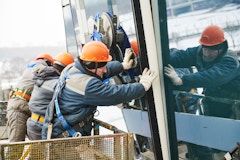
57 results
-
 Reducing greenhouse gas emissions from the building sector is critical to limiting global temperature rise to less than 1.5⁰C. Construction and…
Reducing greenhouse gas emissions from the building sector is critical to limiting global temperature rise to less than 1.5⁰C. Construction and… -
Facade Maintenance Access
- Paper by Carmen Chun, MEng, P.Eng., LEED® AP, Associate Leonard Pianalto MSc (Civil), P.Eng., LEED® AP, FEC, Managing Principal
Facades are an architectural feature and an integral part of the building enclosure. To ensure that the facades continue their function, they must be… -
Contextualizing Glass and Carbon Impacts
- Paper by Kayla Natividad, PhD, WELL AP, LEED Green Associate · Kyle Sword
Climate change goals will require significant improvements in the way buildings are constructed and operated. Building reuse can combat climate
-

Event Passed
Abstracts Deadline: Wagdy Anis Symposium on Building Science 2021
Call for Abstracts Building on the success of their 2019 event, the Boston Building Enclosure Council is planning a second symposium in honor of Wagdy Anis. The theme for 2021 is based on a central tenet of Wagdy’s career: high performance building enclosures will reward building owners with both...
Industry Event by Boston Society for Architecture
-

-

BESTfest
- Event by National Institute of Building Sciences
Since the beginning of the pandemic, building enclosures have received closer scrutiny, with everyone from consumers to building professionals to local and federal government, wanting to know more about their technologies and performance. The BESTfest seminar brings together industry leaders and...
-
Tool For Facade Inspection Traceability
- Paper by John Medina, Owner, Senior Principal Jorge Moya, Forensic and Chemical Analyst Maria Moral, Architect - Junio Principal Guillermo Saavedra, Architect - Junior Principal
Building façade inspections have multiple objectives, such as forensic investigation of a failure, maintenance code compliance, etc. Architects,… -

Active and Energy Autonomous Window
- Paper by Annalisa Andaloro · Leire Minguez Hilera · Stefano Avesani
Reducing GHG emissions related to energy use in buildings is a prominent obligation given their impact in terms of climate change. In this light,
-

Event Passed
Sisteccer XIII — International Facade Conference
- Buenos Aires, Argentina
SISTECCER, a joint production of ALUAR, DOW and VASA, has been consolidated through its previous twelve editions as a meeting place of excellence with experts from the country and abroad, to expand knowledge in technologies for building envelopes.
Industry Event by SISTECCER — International Facades Congress
-

FTI DIALOGUES: Collaborative Project Delivery Reloaded
- Article by April Rawson, FTI Special Advisory Council
The Facade Tectonics Institute kicked off their first installment of FTI Dialogues: Suppliers & Contractors Series virtually on Friday, March 19th. High-performance facade systems are recognized as a key element in achieving sustainable building performance while also being tasked with providing
-

Event Passed
PowerSKIN Conference
The next PowerSKIN Conference will be held virtually in Munich on April 9th. The focus of the 2021 conference deals with the question of whether simplicity and robustness are in contradiction to good performance or whether they even complement each other: Simplicity vs. Performance?
Industry Event by TU Delft
-

Event Passed
PowerSkin Conference 2022
- Germany
The PowerSkin Conference aims to address the role of building skins to accomplish a carbon neutral building stock.
Industry Event by European Facade Network
-

Towards Net Zero Enclosures
- Paper by Jessica Santonastaso, AIA, Architect, Associate Alan Estabrook, AIA, Architect, Associate
As architects and designers we understand the urgency of addressing the building sector’s role in the ongoing environmental crisis. Architecture2030… -
Evaluating The Environmental Performance Of Stick Curtain Wall Systems
- Paper by Dima Othman · Daniel Arztmann
The construction industry is one of the greatest sources of pollution, where 39% of global energy-related carbon emissions are attributed to
-
Growing Myceliated Facades
- Paper by Thibaut Houette, M. Arch. · Brian Foresi · Christopher Maurer, AIA, NCARB · Dr. Petra Gruber
Today's sustainability in architecture takes into consideration the complete life cycle of buildings and their components, from resource harvesting
-
Carbon-Neutral High-Rise Envelope Nexus
- Paper by Thomas Spiegelhalter
The pathway to carbon-neutrality, as urged during the COP 21 in Paris, and the repeated goal for resilient buildings and urban habitats, winds right
-

Event Passed
–EFN Conference the Future Envelope - “Towards Zero Carbon”
- Bozen/Bolzano, Italy
The conference aims at providing new points of view on the current state, upcoming challenges, and innovations in the field.
Industry Event by European Facade Network
-

The Carbon Footprint of Aluminum Fenestration
- Paper by Tom Bougher, Director of Applied Research Richard Braunstein, Vice President of R&D
The historical focus on reducing the carbon footprint of a building has recently shifted to include more emphasis on embodied carbon, the carbon… -
OpenFacadeControl
- Paper by Peter Grant, Technology Researcher II Tzu-Ching Su, Deputy Manager Luis Fernandes, Jordan Shackelford, Technology Researcher III Anand Prakash, Senior Scientific Engineering Associate Stephen Czarnecki, Software Developer Pei-Yu Yu, Deputy Division Director Feng-Yi Lin, Engineer
Automated facades are, for the most part, still considered as separate from other building systems throughout the design, installation,… -

Prefab Facades – from Prototype to Product?
- Paper by Lisa Rammig · Andrea Zani · Tim Murphy
Building envelopes are not only an immediately visible part of the building, they have also become a major factor both for cost and performance of
